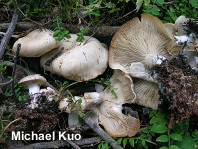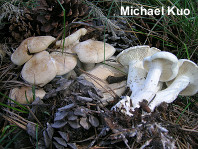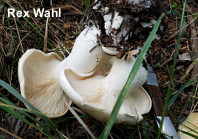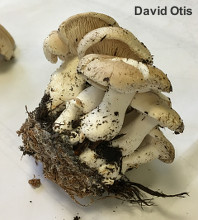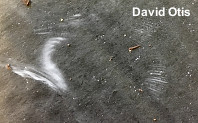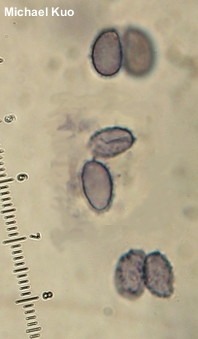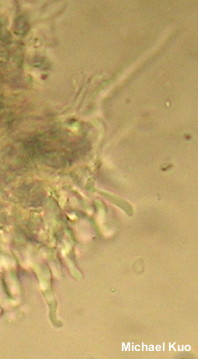| Major Groups > Gilled Mushrooms > Pale-Spored > Leucopaxillus > Leucopaxillus albissimus |

|
Leucopaxillus albissimus [ Basidiomycota > Agaricales > Tricholomataceae > Leucopaxillus . . . ] by Michael Kuo Leucopaxillus albissimus is a medium-sized to large decomposer of conifer debris with highly variable cap colors—ranging from the "whitest" white referred to by the species name "albissimus," to buff, pinkish, pale brownish, or pale tan. Its whitish to pale yellowish gills, like the gills in most species of Leucopaxillus, can be separated from the cap as a layer (slide the tip of your thumb near the apex of the stem), and copious white mycelium extends from the stem base. Many varieties and forms of Leucopaxillus albissimus have been described on the basis of tastes, colors, and geography. At least one of these taxa (Leucopaxillus paradoxus) is considered a separate species by some mycologists. Hardwood litter-decomposing versions of Leucopaxillus albissimus have been recorded, but these are rare and, at least in eastern North America, may better correspond to Leucopaxillus laterarius. The latter species can also be separated on the basis of its shorter spores. Thanks to David Otis and Rex Wahl for collecting, documenting, and preserving Leucopaxillus albissimus for study; their collections are deposited in The Herbarium of Michael Kuo. Description: Ecology: Saprobic, decomposing the litter of conifers; growing scattered, gregariously, or in arcs or fairy rings; summer and fall (over winter in warmer climates); widely distributed in North America. The illustrated and described collections are from Colorado, New Mexico, and Illinois. Cap: 5–13 cm; convex with an inrolled margin when young, becoming broadly convex to nearly flat; dry; bald or very finely velvety (like kid leather); off-white to pale tan, developing brownish shades with age and/or toward the center. Gills: Attached to the stem or beginning to run down it; close; short-gills frequent; separable from the cap as a layer; whitish. Stem: 4–8 cm long; 1.5–3 cm thick; more or less equal; bald or slightly fibrillose; whitish; with prominent and copious white basal mycelium. Flesh: White; thick; hard; not changing when sliced. Odor and Taste: Odor mealy, foul, or not distinctive. Spore Print: White. Chemical Reactions: Cap surface negative with KOH. Microscopic Features: Spores 4–8 x 4–5 µm (including ornamentation); broadly ellipsoid; finely spiny with spines under 0.5 µm high (ornamentation occasionally too low to be observed at 1000 X); amyloid. Basidia 4-spored. Cheilocystidia 25–50 x 2.5–5 µm; cylindric-flexuous or slightly irregular; smooth; hyaline in KOH. Pleurocystidia not found. Pileipellis a poorly defined cutis of hyphae 2.5–5 µm wide, hyaline in KOH, clamped at septa. REFERENCES: (Peck, 1873) Singer, 1939. (Kauffman, 1918; Singer & Smith, 1943; Smith, Smith & Weber, 1979; Arora, 1986; States, 1990; Phillips, 1991/2005; Lincoff, 1992; Miller & Miller, 2006; Trudell & Ammirati, 2009; Kuo & Methven, 2014; Desjardin, Wood & Stevens, 2016; Evenson, 2016; Siegel & Schwarz, 2017; Cripps, Evenson & Kuo, 2017.) Herb. Kuo 08160701, 11091601, 08171701. Herb DBG RMNP 2008-014, RMNP 2008-138, RMNP 2012 5022-26, RMNP 5028-19. This site contains no information about the edibility or toxicity of mushrooms. |
© MushroomExpert.Com |
|
Cite this page as: Kuo, M. (2017, November). Leucopaxillus albissimus. Retrieved from the MushroomExpert.Com Web site: http://www.mushroomexpert.com/leucopaxillus_albissimus.html |
